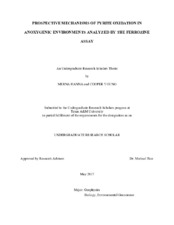| dc.creator | Young, Cooper Alec | |
| dc.creator | Hanna, Merna | |
| dc.date.accessioned | 2020-08-03T18:21:14Z | |
| dc.date.available | 2020-08-03T18:21:14Z | |
| dc.date.created | 2018-05 | |
| dc.date.issued | 2017-05-03 | |
| dc.date.submitted | May 2018 | |
| dc.identifier.uri | https://hdl.handle.net/1969.1/188544 | |
| dc.description.abstract | Pyrite survived extensive redox weathering in the Archean (4.0-2.5 Ga) due to lack of readily available atmospheric oxygen in coastal, shallow-water environments. However, instances of oxidized detrital pyrite are still found that date as far back as 3.22 Ga. Three hypotheses have been proposed to explain oxidation of pyrite in the Paleoarchean (3.6-3.2 Ga): (1) Oxygenic photosynthesis, (2) Anoxygenic phototrophy, and (3) Photooxidation. Each of these three hypotheses provide ample, yet debatable amount of evidence to support pyrite oxidation. In this research, we investigated prospective oxidation mechanisms of pyrite in the Paleoarchean Era utilizing the ferrozine assay. It was determined that it is possible to quantify the amount of pyrite oxidized in an anoxygenic environment utilizing the ferrozine assay. | en |
| dc.format.mimetype | application/pdf | |
| dc.subject | Pyrite | en |
| dc.subject | photooxidation | en |
| dc.subject | anoxygenic oxidation | en |
| dc.title | Prospective Mechanisms of Pyrite Oxidation in Anoxygenic Environments Analyzed by the Ferrozine Assay | en |
| dc.type | Thesis | en |
| thesis.degree.department | Environmental Programs in Geosciences | en |
| thesis.degree.discipline | Environmental Geosciences | en |
| thesis.degree.grantor | Undergraduate Research Scholars Program | en |
| thesis.degree.name | BS | en |
| thesis.degree.level | Undergraduate | en |
| dc.contributor.committeeMember | Tice, Michael | |
| dc.type.material | text | en |
| dc.date.updated | 2020-08-03T18:21:14Z | |


